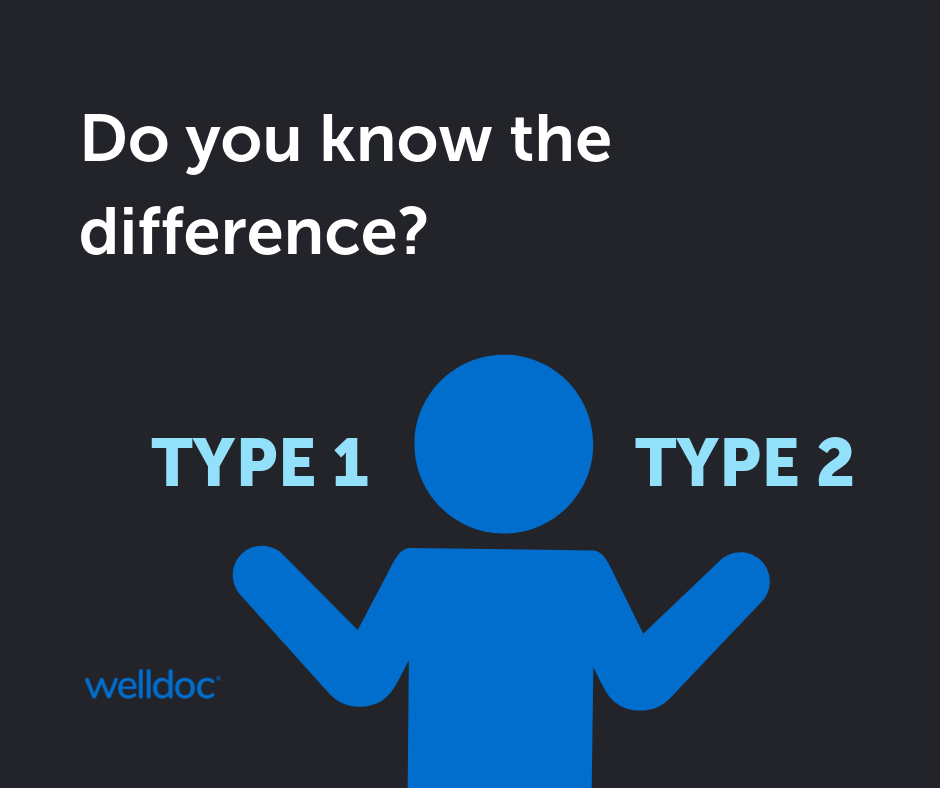Whether you are living with diabetes or know someone who is, there is an abundance of information out there. We know it can be difficult to keep it all straight. We’re here to help break down some key information about diabetes. So, what is the difference between type 1 and type 2 diabetes?
Overview
The main difference between type 1 and type 2 diabetes comes down to the body’s relationship with insulin. Insulin is a hormone that helps regulate the amount of glucose in the bloodstream. It does this by helping glucose enter cells in the body for you to use as energy. For people with type 1 diabetes, their body does not produce insulin at all. On the other hand, people with type 2 diabetes produce insulin, but their bodies cannot use it properly. This is also known as insulin resistance. Chronically high blood glucose can be damaging and may lead to other serious health problems.1
Causes and Risk Factors
Type 1
The exact cause of type 1 diabetes is unknown. However, for most people with type 1 diabetes, their “immune system… mistakenly destroys insulin-producing cells in the pancreas2.” Once these cells have been destroyed, the pancreas can no longer produce insulin. This makes it difficult to control the amount of glucose in the bloodstream.
While there is no known way to prevent type 1 diabetes, there are a few factors that can make you more likely to get it, including:
- Family history
- Genetics
- Contracting certain viruses that may trigger the autoimmune response
Type 2
About 90% to 95% of Americans with diabetes have type 2 diabetes1. There are a few factors that can lead to a person developing type 2 diabetes including:
- Family history
- Genetics
- Being 45 Years or older
- Having a previous diagnosis of gestational diabetes or prediabetes
- Being overweight
- Being physically active less than 3 times per week
Type 2 diabetes even has a stronger link to family history than type 1 diabetes. Unlike type 1 diabetes, there are steps you can take to help reduce the risk of developing type 2 diabetes. Lifestyle changes like losing weight, making healthier food choices, and getting regular exercise can reduce your risk of developing type 2 diabetes.
Signs and Symptoms 3
As you may know, the number of U.S. adults living with type 2 diabetes is on the rise. However, nearly a quarter of people with diabetes don’t even know they have it. What are some common symptoms to look out for?
- Increased thirst
- Increased hunger
- Frequent urination
- Unintended weight loss
- Fatigue
- Blurred vision
- Slow-healing cuts or bruises
- Frequent infections
- Tingling, pain, or numbness in hands/feet (type 2)
Treatment Overview
There is not a single “best treatment” for people with either type 1 or type 2 diabetes. Everyone is different and will need to work with their care team to develop a treatment plan that is right for them. However, there are a few key differences in how type 1 and type 2 diabetes are managed.
Since people with type 1 diabetes are unable to produce insulin, insulin therapy is used to help manage blood glucose. In addition, patients are asked to make changes in their diet and exercise habits2.
Some people with type 2 diabetes can manage their blood glucose with healthy eating and exercise. Others may need to also use insulin or medications to help lower their blood glucose.
Living with diabetes
At Welldoc, we know that education is key when managing a chronic illness like diabetes. That’s why we’ve developed BlueStar to provide real time feedback, reports and insights, and provide resources to help people with diabetes manage it better.





